Family: Siricidae
Family common name: horntails
Subfamily: Siricinae
Genus: Urocerus Geoffroy, 1762
Subgenera: none
The Siricidae are called “horntails” because of the cornuscornus:
a pointed horn-like process on the apical end of the abdomen in Siricidae sawflies; on tergite 10 in females, sternite 9 in males
 , a short spine at the apexapex:
, a short spine at the apexapex:
the end or most distal area of any structure
of the abdomenabdomen:
the third and last segment of an insect's body; in sawflies this is usually made up of 11 segments (segments 9 and 10 often fused)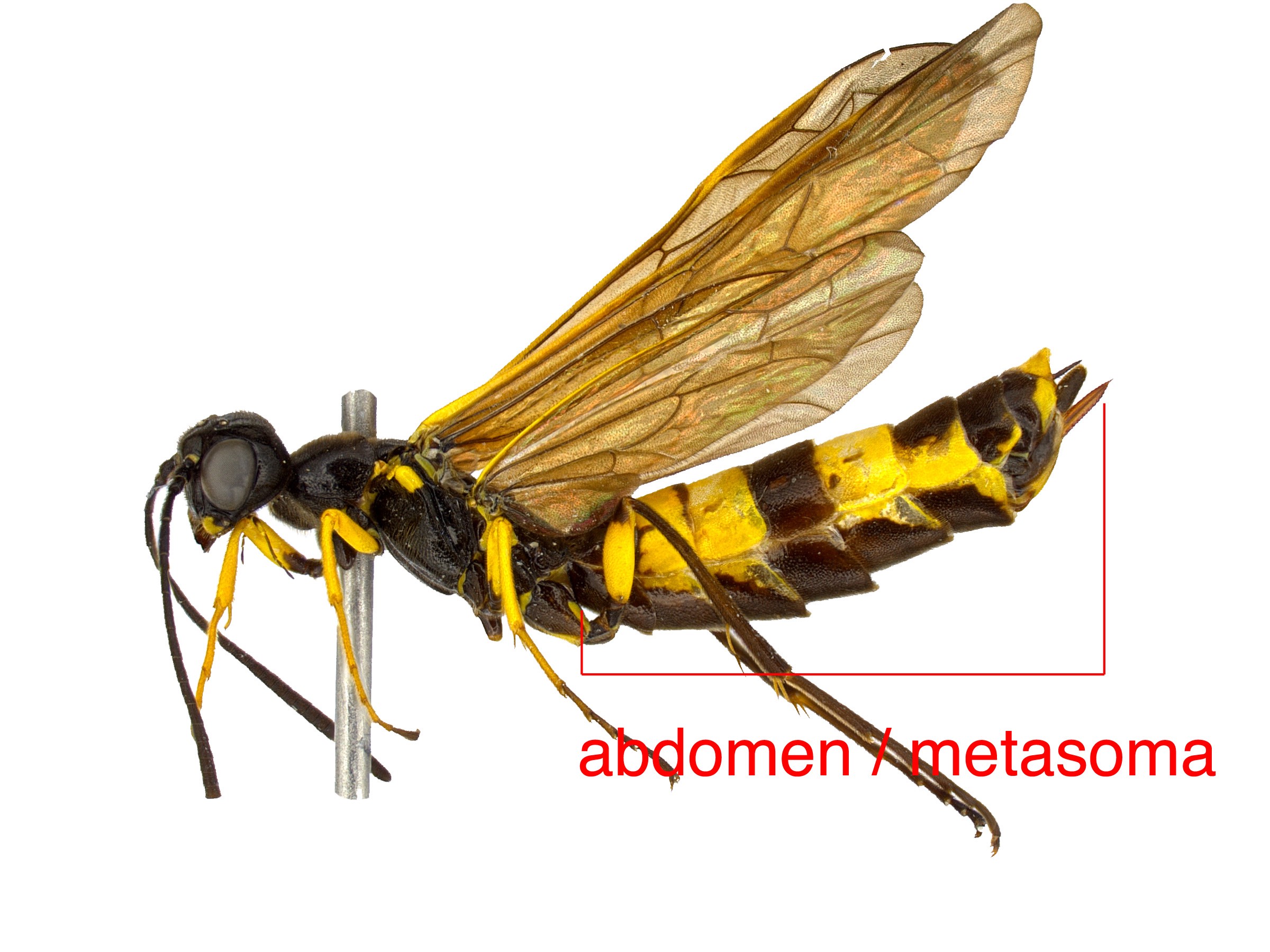 . Females in the family also possess a long, conspicuous ovipositorovipositor:
. Females in the family also possess a long, conspicuous ovipositorovipositor:
the female organ that deposits eggs and is used to drill into plant tissue, located at the apex of the abdomen, made up of the lance and lancet
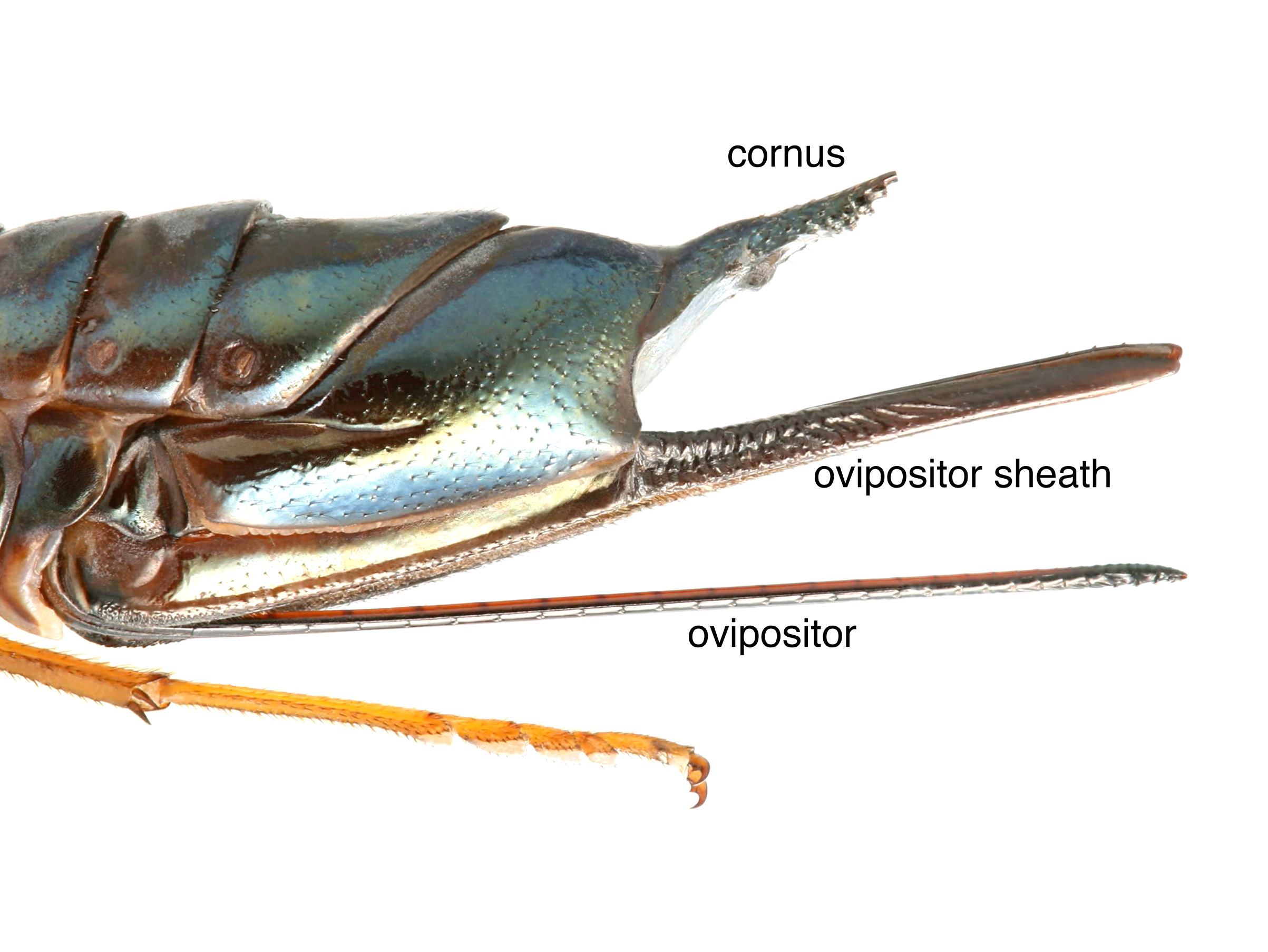 . This is often mistaken for a stinger, but it is harmless to animals and used for drilling into wood. This habit has inspired the other common name of this family: “woodwasps” (Klass 1974Klass 1974:
. This is often mistaken for a stinger, but it is harmless to animals and used for drilling into wood. This habit has inspired the other common name of this family: “woodwasps” (Klass 1974Klass 1974:
Klass C. 1974. Horntails or wood wasps. Insect Diagnotic Laboratory Cornell University.).
Horntails of the genus Urocerus are generally large, about 2.5–4 cm in length, with cylindrical bodies (Camper and Cranshaw 2018Camper and Cranshaw 2018:
Camper M and Cranshaw W. n.d. European woodwasp/Sirex woodwasp in Colorado - identification of insects and damage of similar appearance. Colorado Exotic Insect Detection and Identification Fact Sheet Series. Online Accessed Dec. 2018.). They are usually shining black with reddish-brown and sometimes light-colored or white areas. Females are generally larger than males, but because body size is highly variable within species, sexes are best distinguished by presence or absence of the long ovipositorovipositor:
the female organ that deposits eggs and is used to drill into plant tissue, located at the apex of the abdomen, made up of the lance and lancet
 (Camper and Cranshaw 2018Camper and Cranshaw 2018:
(Camper and Cranshaw 2018Camper and Cranshaw 2018:
Camper M and Cranshaw W. n.d. European woodwasp/Sirex woodwasp in Colorado - identification of insects and damage of similar appearance. Colorado Exotic Insect Detection and Identification Fact Sheet Series. Online Accessed Dec. 2018.). The wings of Urocerus are commonly smoky, golden, or dark-colored, and occasionally sub-hyaline (Schiff et al. 2006Schiff et al. 2006:
Schiff NM, Valley SA, LaBonte JR, and Smith DR. 2006. Guide to the siricid woodwasps of North America. USDA Forest Service Forest Health Technology Enterprise Team FHTET-2006-15. 102 pp.).
Worldwide, there are 33 described species. The diversity in North America is low, with only five endemicendemic:
both native and unique to a particular region
and one introduced species (Schiff et al. 2012Schiff et al. 2012:
Schiff NM, Goulet H, Smith DR, Boudreault C, Wilson AD, and Scheffler BE. 2012. Siricidae (Hymenoptera: Symphyta: Siricoidea) of the Western Hemisphere. Canadian Journal of Arthropod Identification 21: 1-305.).
A key to North American species of Urocerus is included in Schiff et al. 2012Schiff et al. 2012:
Schiff NM, Goulet H, Smith DR, Boudreault C, Wilson AD, and Scheffler BE. 2012. Siricidae (Hymenoptera: Symphyta: Siricoidea) of the Western Hemisphere. Canadian Journal of Arthropod Identification 21: 1-305..
 (Schiff et al. 2012Schiff et al. 2012:
(Schiff et al. 2012Schiff et al. 2012: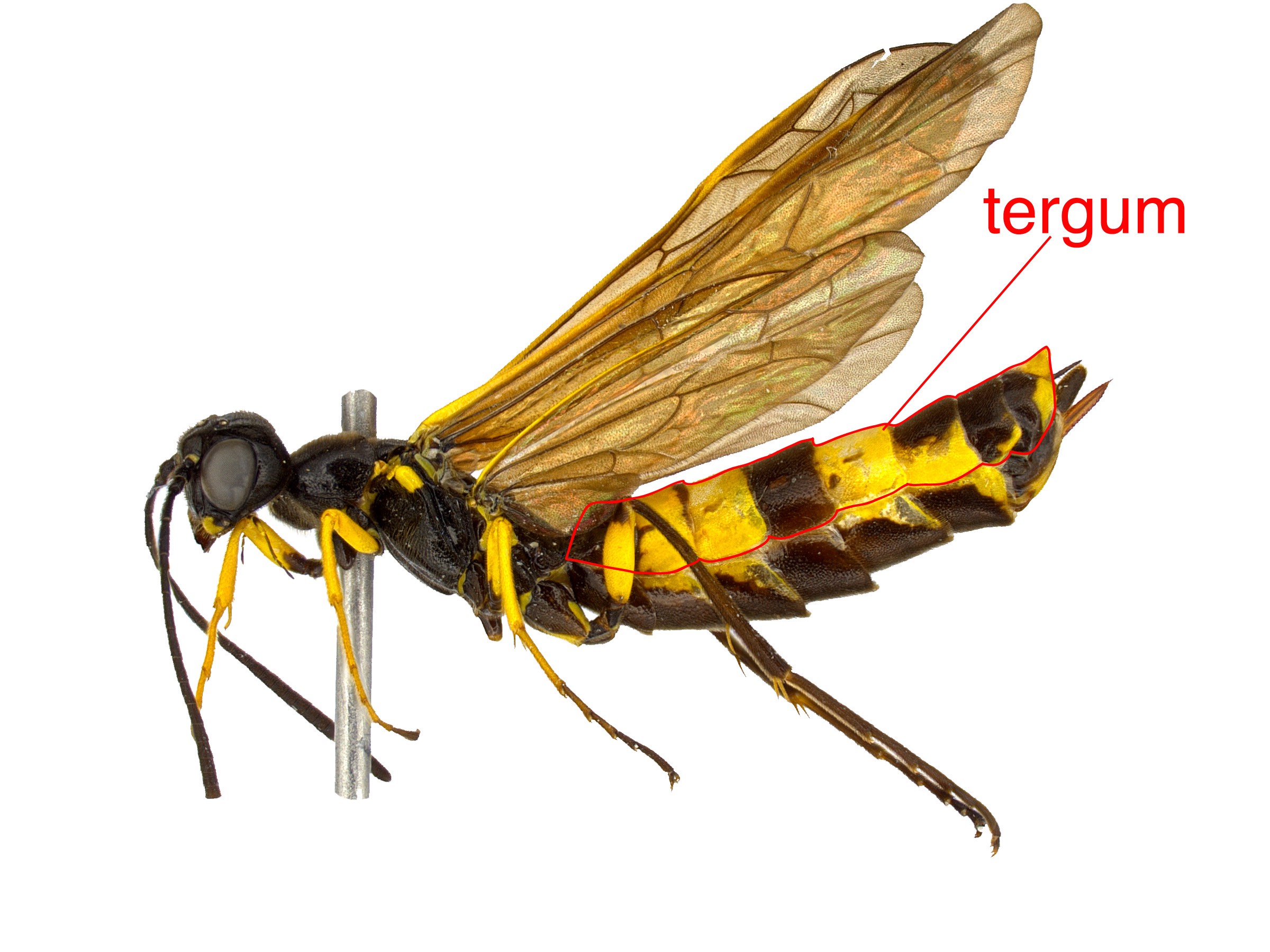 10 of the female, sternumsternum:
10 of the female, sternumsternum: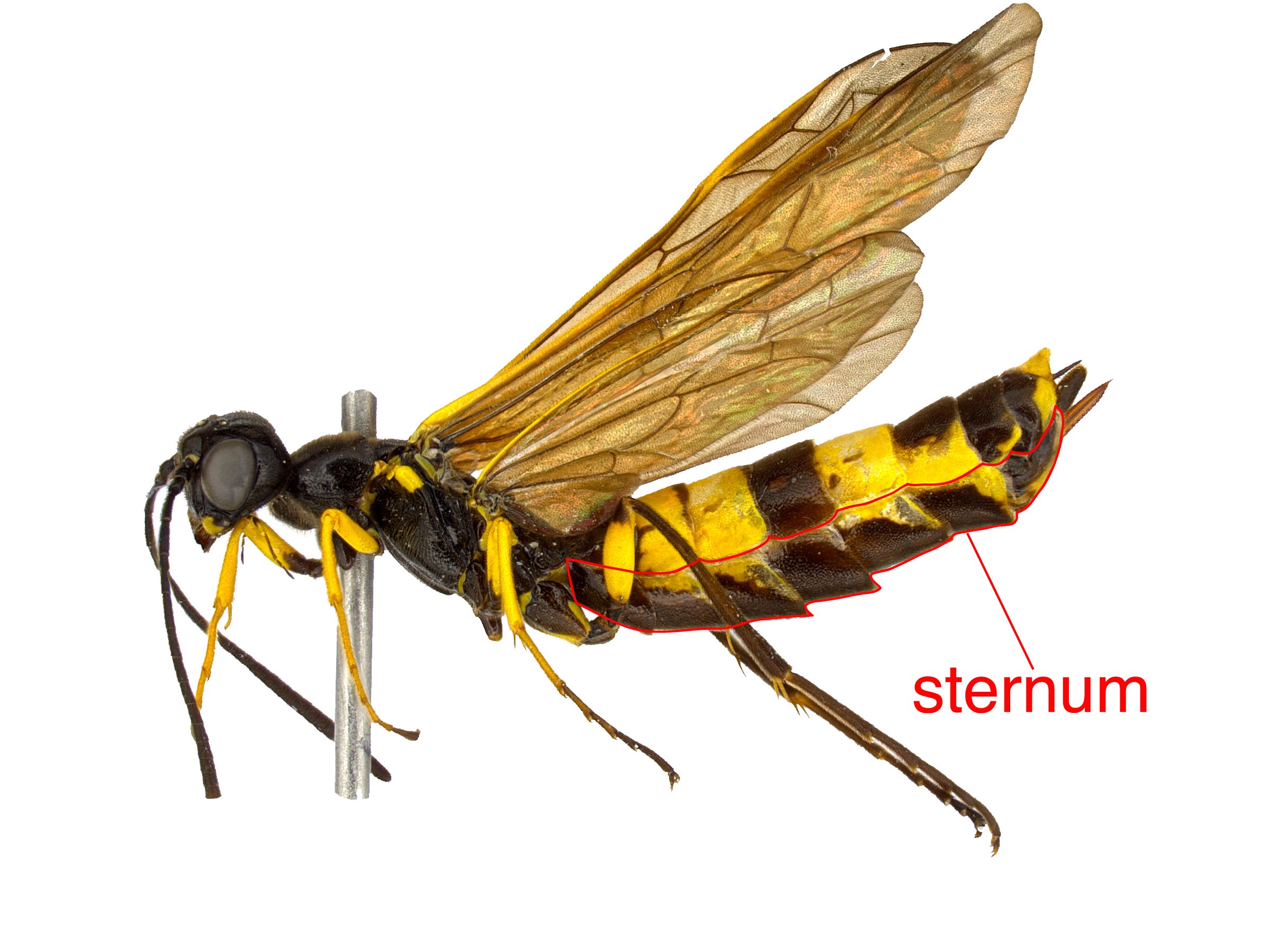 9 of the male, known as the cornuscornus:
9 of the male, known as the cornuscornus: (Schiff et al. 2012Schiff et al. 2012:
(Schiff et al. 2012Schiff et al. 2012: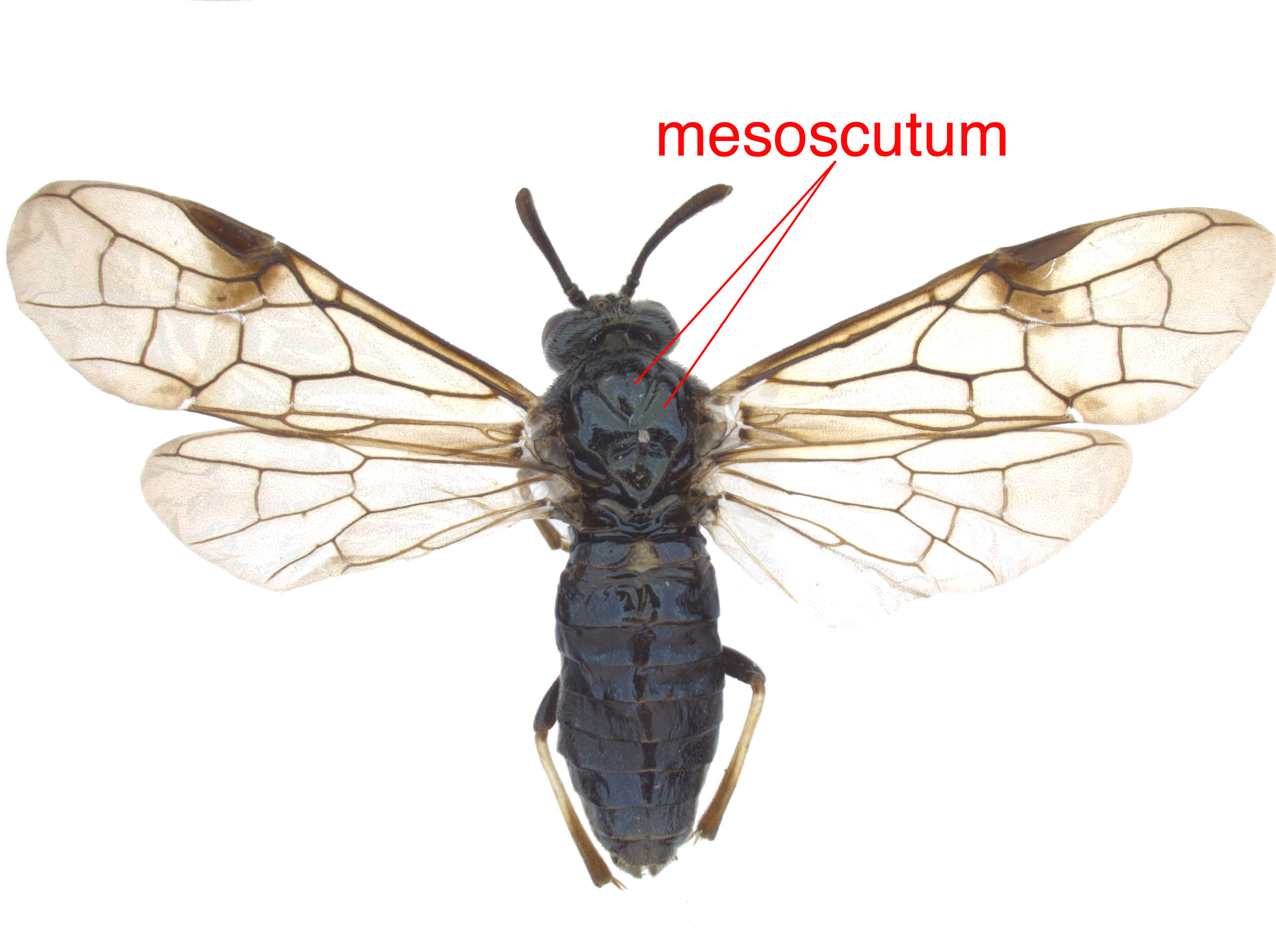 (Schiff et al. 2012Schiff et al. 2012:
(Schiff et al. 2012Schiff et al. 2012: (Schiff et al. 2012Schiff et al. 2012:
(Schiff et al. 2012Schiff et al. 2012: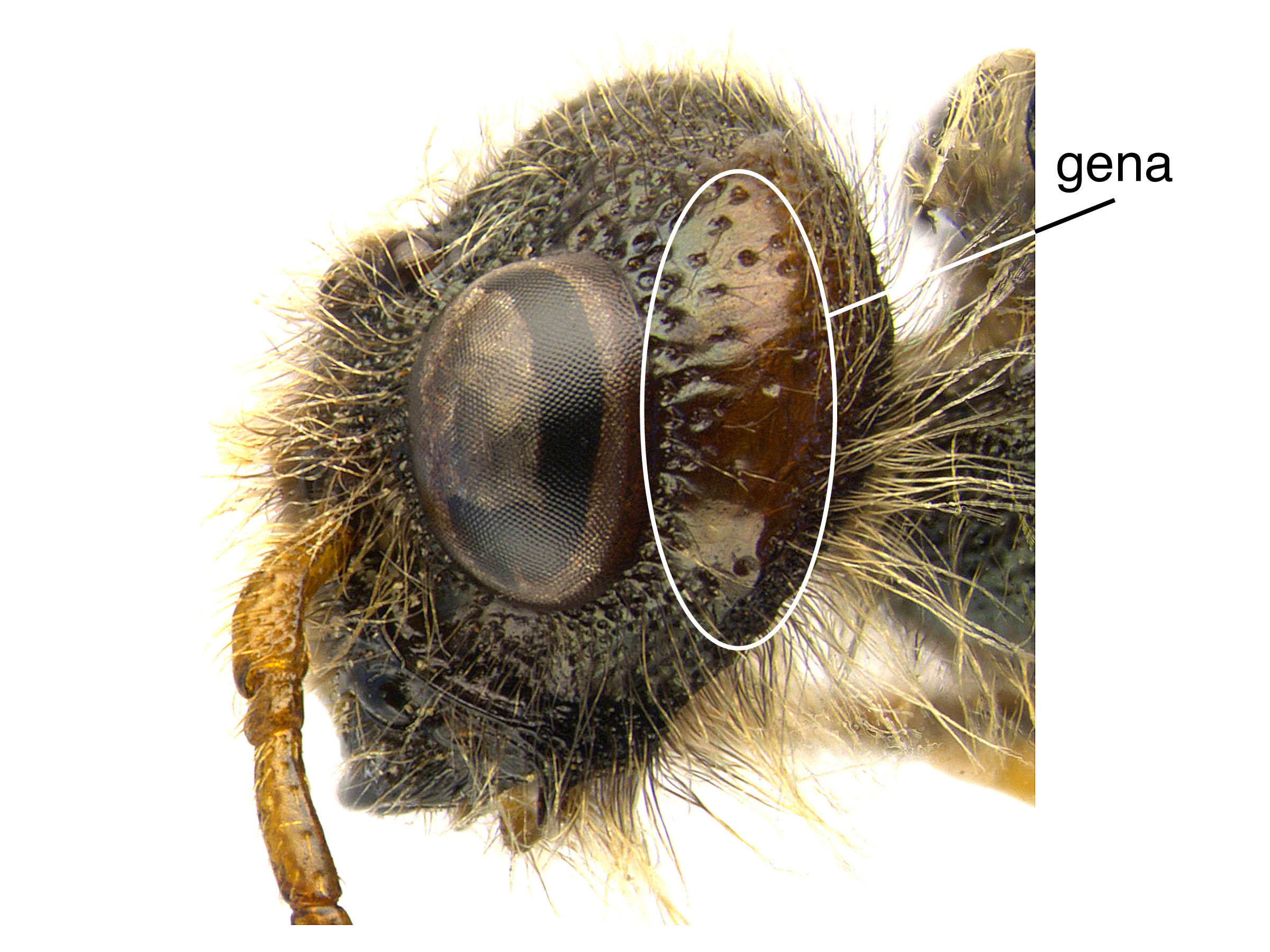 (Schiff et al. 2012Schiff et al. 2012:
(Schiff et al. 2012Schiff et al. 2012: mostly smooth (Schiff et al. 2012Schiff et al. 2012:
mostly smooth (Schiff et al. 2012Schiff et al. 2012: slightly constricted near the basebase:
slightly constricted near the basebase:Urocerus can be confused with other Siricidae, especially Sirex because of the similar coloration. They can be distinguished from other genera in the family by the lack of ridge on the genagena:
the area of the head between the compound eye and clypeus; also called the cheek
 behind the eye and lack of metallic reflections on black portions of the body (Schiff et al. 2012Schiff et al. 2012:
behind the eye and lack of metallic reflections on black portions of the body (Schiff et al. 2012Schiff et al. 2012:
Schiff NM, Goulet H, Smith DR, Boudreault C, Wilson AD, and Scheffler BE. 2012. Siricidae (Hymenoptera: Symphyta: Siricoidea) of the Western Hemisphere. Canadian Journal of Arthropod Identification 21: 1-305.).
Siricidae are commonly intercepted in wood packing materials at ports of entry. The potential of larval stages to persist and develop for multiple years increases the potential of successful establishment from improperly treated or disposed of wood material.
Urocerus sah has become established in New Hampshire and Quebec. In its native range of West Asia and North Africa, it utilizes Abies spp. (fir), Picea spp. (spruce), and Pinus spp. (pine) as hosts. No specimens have yet been reared from North American hosts (Smith 1978Smith 1978:
Smith DR. 1978. Suborder Symphyta (Xyelidae, Parachexyelidae, Parapamphiliidae, Xyelydidae, Karatavitidae, Gigasiricidae, Sepulcidae, Pseudosiricidae, Anaxyelidae, Siricidae, Xiphydriidae, Paroryssidae, Xyelotomidae, Blasticotomidae, Pergidae). Hymenopterorum Catalogus 14: 1-193., Schiff et al. 2012Schiff et al. 2012:
Schiff NM, Goulet H, Smith DR, Boudreault C, Wilson AD, and Scheffler BE. 2012. Siricidae (Hymenoptera: Symphyta: Siricoidea) of the Western Hemisphere. Canadian Journal of Arthropod Identification 21: 1-305.).
Urocerus species have been documented from hosts in the Cupressaceae and Pinaeceae, including Chamaecyparis sp. (false cypress), Calocedrus decurrens (incense cedar), Thuja occidentalis (arborvitae), Thuja plicata (western red cedar), Taxodium distichum (bald cypress), Abies spp. (fir), Cedrus spp. (cedar), Larix spp. (larch), Picea spp. (spruce), Pinus spp. (pine), Pseudotsuga menziesii (Douglas fir), and Tsuga heterophylla (western hemlock) (Schiff et al. 2012Schiff et al. 2012:
Schiff NM, Goulet H, Smith DR, Boudreault C, Wilson AD, and Scheffler BE. 2012. Siricidae (Hymenoptera: Symphyta: Siricoidea) of the Western Hemisphere. Canadian Journal of Arthropod Identification 21: 1-305.).
Female Urocerus harbor symbiotic basidiomycete fungus in abdominal glands called mycangia. During oviposition, the site is inoculated with the fungus, which begins to decompose the surrounding wood. LarvaeLarva:
the immature stage of holometabolous insects
 feed on the fungus, and in the process bore galleries through the wood. The fungal symbiont for two species of Urocerus in Asia (U. japonicus and U. antennatus) has been identified as Amylostereum laevigatum, and for five others in Europe, West Asia, and North America (U. californicus, U. flavicornis, U. gigas, U. augur and U. sah) as Amylostereum chailletti. Females reserve mucus in additional abdominal glands, but the function of these reservoirs is not well understood; the excreted mucus may encourage fungal growth. Urocerus species lay eggs a few at a time, spaced singly along a single long drill, with fungal hyphae between each one (Schiff et al. 2012Schiff et al. 2012:
feed on the fungus, and in the process bore galleries through the wood. The fungal symbiont for two species of Urocerus in Asia (U. japonicus and U. antennatus) has been identified as Amylostereum laevigatum, and for five others in Europe, West Asia, and North America (U. californicus, U. flavicornis, U. gigas, U. augur and U. sah) as Amylostereum chailletti. Females reserve mucus in additional abdominal glands, but the function of these reservoirs is not well understood; the excreted mucus may encourage fungal growth. Urocerus species lay eggs a few at a time, spaced singly along a single long drill, with fungal hyphae between each one (Schiff et al. 2012Schiff et al. 2012:
Schiff NM, Goulet H, Smith DR, Boudreault C, Wilson AD, and Scheffler BE. 2012. Siricidae (Hymenoptera: Symphyta: Siricoidea) of the Western Hemisphere. Canadian Journal of Arthropod Identification 21: 1-305.).
Larvae are creamy white and grub-like in appearance with a dark head capsule. As with adults, larvaelarva:
the immature stage of holometabolous insects
 possess a short dorsaldorsal:
possess a short dorsaldorsal:
of or on the top surface of the body or structure
horn on the posterior end of the body. At maturity, the body measures about 2.5 cm in length (Schiff et al. 2012Schiff et al. 2012:
Schiff NM, Goulet H, Smith DR, Boudreault C, Wilson AD, and Scheffler BE. 2012. Siricidae (Hymenoptera: Symphyta: Siricoidea) of the Western Hemisphere. Canadian Journal of Arthropod Identification 21: 1-305.). The larvaelarva:
the immature stage of holometabolous insects
 bore galleries 5–20 cm long while developing through 6–12 larval instars, depending on food availability, until pupation and subsequent emergence. Throughout this process, the larvaelarva:
bore galleries 5–20 cm long while developing through 6–12 larval instars, depending on food availability, until pupation and subsequent emergence. Throughout this process, the larvaelarva:
the immature stage of holometabolous insects
 use their horn to pack the tunnel behind them with sawdust. Emergence holes are perfectly circular. The fungal symbiont is carried in specialized organs in female larvaelarva:
use their horn to pack the tunnel behind them with sawdust. Emergence holes are perfectly circular. The fungal symbiont is carried in specialized organs in female larvaelarva:
the immature stage of holometabolous insects
 that develop into the mycangia after metamorphosis. The life cycle of Urocerus species varies from 1–3 years (Schiff et al. 2012Schiff et al. 2012:
that develop into the mycangia after metamorphosis. The life cycle of Urocerus species varies from 1–3 years (Schiff et al. 2012Schiff et al. 2012:
Schiff NM, Goulet H, Smith DR, Boudreault C, Wilson AD, and Scheffler BE. 2012. Siricidae (Hymenoptera: Symphyta: Siricoidea) of the Western Hemisphere. Canadian Journal of Arthropod Identification 21: 1-305.).
Adult males have been observed swarming and waiting for a female to enter the swarm for mating. There is some evidence that trees with sustained damage, either from drought-related stress, weather, or other insect infestations, are preferred as hosts (Burnip et al. 2010Burnip et al. 2010:
Burnip GM, Voice D, and Brockerhoff EG. 2010. Interceptions and incursions of exotic Sirex species and other siricids (Hymenoptera: Siricidae). New Zealand Journal of Forestry Science 40: 133-140.). In some cases, females oviposit in fire-damaged trees. Adult Siricidae are not well-studied (Schiff et al. 2012Schiff et al. 2012:
Schiff NM, Goulet H, Smith DR, Boudreault C, Wilson AD, and Scheffler BE. 2012. Siricidae (Hymenoptera: Symphyta: Siricoidea) of the Western Hemisphere. Canadian Journal of Arthropod Identification 21: 1-305.).
World: Except for one species, Urocerus is restricted to the Northern Hemisphere. Species are found throughout North America, Europe, North Africa, and Asia. One species, U. gigas, has been introduced to South America and is recorded from Chile, Argentina, and Brazil (Smith 1978Smith 1978:
Smith DR. 1978. Suborder Symphyta (Xyelidae, Parachexyelidae, Parapamphiliidae, Xyelydidae, Karatavitidae, Gigasiricidae, Sepulcidae, Pseudosiricidae, Anaxyelidae, Siricidae, Xiphydriidae, Paroryssidae, Xyelotomidae, Blasticotomidae, Pergidae). Hymenopterorum Catalogus 14: 1-193.).
North America: Urocerus occurs throughout continental North America south to Mexico. Generally they are established where coniferousconiferous:
describing a conifer
trees grow densely, most often along mountain ranges. Two species are widespread; one species is restricted to the west, and two are restricted to the east. One species, U. sah, native to West Asia, has become established in eastern North America (Smith 1978Smith 1978:
Smith DR. 1978. Suborder Symphyta (Xyelidae, Parachexyelidae, Parapamphiliidae, Xyelydidae, Karatavitidae, Gigasiricidae, Sepulcidae, Pseudosiricidae, Anaxyelidae, Siricidae, Xiphydriidae, Paroryssidae, Xyelotomidae, Blasticotomidae, Pergidae). Hymenopterorum Catalogus 14: 1-193.).
Map data from: GBIF.org (26 June 2019) GBIF Occurrence Download Urocerus
Details about data used for maps can be found here.